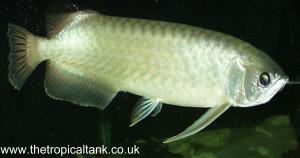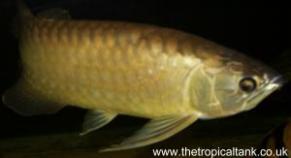|
|
Asian arowana/Dragon fish


Photos © Sean Evans
|
| Common name: | Asian arowana, Dragon fish, Asian Bonytongue |
| Scientific name: | Scleropages formosus |
| Synonyms: | (none) |
| Size: | Up to 36" (92cm) reported, but usually smaller in aquariums - around 18-22" (46-56cm). |
| Origin: | Asia: Cambodia, Indonesia (Kalimantan and Sumatra), Malaysia, Thailand and Vietnam. |
| Tank setup: | A large tank (recommend 6x2x2'/ 183 x 61 x 61cm or larger) with plenty of open swimming space. |
| Compatibility: | Keep with other very large fish which cannot be swallowed. Sometimes aggressive to other species,
probably best kept alone as a specimen fish. Groups of similar sized individuals can be kept together, but this necessitates
huge tanks which are beyond the means of most home aquarists. |
| Temperature: | 24-30oC (75-86oF) |
| Water chemistry: | Soft and acidic (pH 6.0-6.5) ideally, but the exact pH and hardness are not critical - the
water quality is much more important (e.g. low nitrates, zero ammonia and nitrite). |
| Feeding: | Carnivorous: earthworms, insects, will accept dead meaty foods, such as whitebait, mussel and prawn. |
| Sexing: | Very difficult. In mature fish, males may be slimmer and possess a larger mouth and discernable buccal cavity (to incubate eggs). |
| Breeding: | A mouthbrooder, the eggs are carried in the mouth of the male. Has been bred commercially. |
| Comments: |
Silver, gold, red, green and a number of other forms of this fish exist. The red form is particularly prized, as are "crossback" varieties.
Many additional colour varieties have now been produced, and often attract a high price. This species is endangered in the wild,
and is listed under CITES (Convention on International Trade in Endangered Species) Appendix I, meaning that international trade
is tightly restricted. Captive-bred specimens are available to the aquarium trade and must be microchipped and sold with an
accompanying certificate verifying their captive-bred origins.
There are two other species in the genus: S. jardinii and S. leichardti.
|
[Home]
[Article Library]
[Fish Index]
[Tank Setups]
[Forum]
[Site Map]
|
|
|





